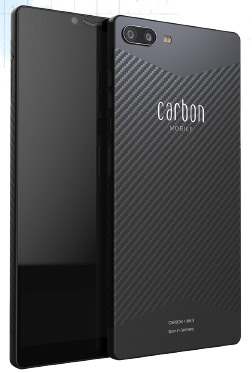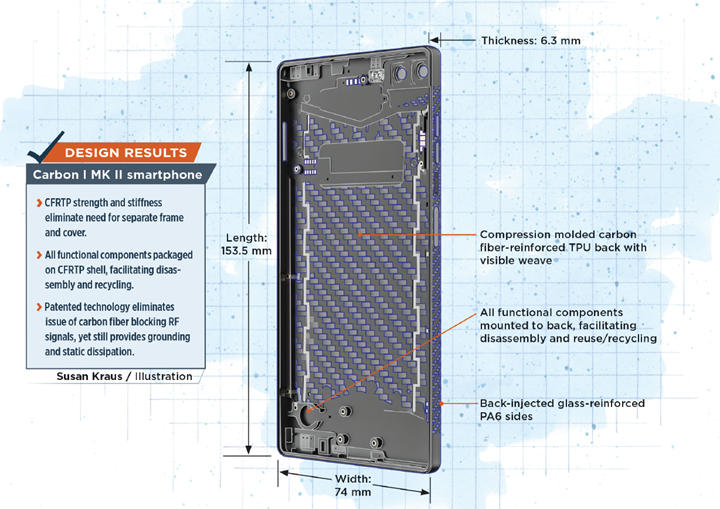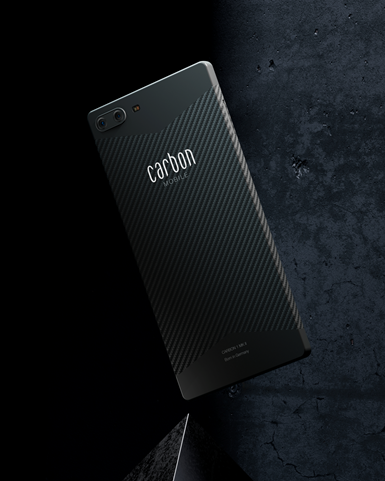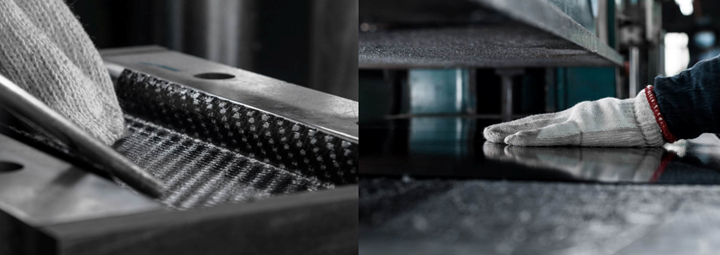
A new smartphone launched last year by startup Carbon Mobile GmbH features what is said to be industry’s lightest, thinnest design, thanks to a CFRTP composite shell that better protects electronics while making the device easier to repair and recycle compared to legacy designs. Other notable innovations include overcoming carbon fiber’s tendency to block radio frequency (RF) signals while also enabling isotropic grounding and electrostatic discharge (ESD) solutions, and designing the device to reduce environmental impact. Photo Credit, all images: Carbon Mobile GmbH
When you first hold a Carbon I MK II (Mark Two) smartphone from Carbon Mobile GmbH (Berlin, Germany), three things are immediately obvious: It’s very light (125 grams versus 182 grams for the average smartphone), it’s very thin (6.3 millimeters versus 8.3 millimeters for the average smartphone) and the rear face features a visible-weave carbon fiber-reinforced composite. Why did a computer engineer turned entrepreneur deploy innovative new composites technology on mobile phones?
“We wanted something that’s tangible, where you could really see and feel the difference as soon as you held it in your hands,” recalls Firas Khalifeh, Carbon Mobile founder and CEO. “Also, from a technical perspective, building a smartphone is one of the most complex consumer products ever made. It features a high density of components and sensors, it’s designed to extremely tight tolerances and it must be as reliable as possible, withstanding many hours of daily use under a variety of conditions, yet last for years. We figured if we could make a game-changing smartphone, we could do pretty much anything else — be it tablets, AR [augmented reality], VR [virtual reality], watches or earphones.”

Carbon Mobile set out to design a game-changing smartphone that was completely different from anything on the market, including using carbon fiber-reinforced composites and seeking design inspiration from Formula 1 race cars and the space industry.
Carbon Mobile’s accomplishments lay in more than just launching a smartly styled carbon fiber-reinforced thermoplastic (CFRTP) bodied smartphone with an Android operating system that sets new standards for lightness and thinness. With this phone, the company has achieved several milestones: it has solved the longstanding issue of carbon fiber blocking radio frequency (RF) signals; it has also developed an isotropic grounding and electrostatic discharge (ESD) solution; and it has pioneered methods to make smartphones greener and more customer friendly.
HPM for HPA
Khalifeh was working at software startups when he became fascinated by the intersection of hardware, art, media and software. At the time, he was prototyping, building virtual malls and working on consumer products like smart refrigerators, and gauging consumer reactions. What he longed to do, however, was build a game-changing smartphone that was completely different from anything on the market. He says his design inspiration was Formula 1 race cars and the space industry; his goal was to produce a high-performance application (HPA) with high-performance materials (HPM), which, to him, meant using carbon fiber-reinforced composites. Rather than starting with an existing smartphone and making a composite body for it, his team went back to their whiteboards to “first principles thinking, to rethink how smartphones are designed and built and then dare each other to ‘break the rules.’”
“Over the last eight years, smartphones have become commodities, so their design has really stagnated — they aren’t even being miniaturized anymore,” explains Khalifeh. “As a consequence, they all look alike, use the same materials and operate the same. What’s more, they create a huge e-waste [electronic waste] problem. We thought that maybe we could do something about this.”
Monocoque design
The initial plan was to build the phone’s monocoque from epoxy/carbon fiber prepreg, but that was changed late in development to carbon fiber/TPU organosheet back-injected in a separate step with short glass fiber/PA6. The change in process and materials was a major decision that helped improve quality control, yield, cost and scalability.
The strength and stiffness of CFRTP is coupled with a clever design that packages all functional components on the monocoque/shell — located on the back side of the smartphone — and closes out the front face by directly bonding the chemically strengthened glass screen onto it. This enables the company to eliminate both the internal metal frame and exterior plastic cover
“In less than five years, with less than a $2 million investment, we’ve built something that was considered impossible,” notes Jamie Clews, Carbon Mobile marketing director.
Late-stage changes
Not suprisingly, given its innovation, a key aspect of the phone’s design was finding the right materials and process to produce it. At first the company worked with epoxy/carbon fiber prepreg. An early challenge was finding necessary electrical and RF data on the materials they were considering, which led to extra testing by the Carbon Mobile team. However, their biggest challenge arrived as they ramped up to launch their first product early in 2020.
“Thermoset composites almost killed our company at a critical point when we were nearing commercialization,” Khalifeh adds with a grimace. “It was early in the pandemic with all the lockdowns and follow-on supply-chain issues. We just couldn’t get material. And while we knew that eventually we would migrate from thermoset to thermoplastics for our matrix, the pandemic gave us time to rethink our choices.”
At that point, the team began searching for automotive-grade CFRTP material suppliers and found their way to Lanxess AG (Cologne (Köln), Germany). Soon, Lanxess’ Tepex continuous fiber-reinforced thermoplastic polyurethane (TPU) organosheet (featuring plies of 3K/3K/1K twill-weave carbon fiber fabric) was specified for the rear face of the monocoque. This is compression molded, then separately back injection molded with a short-fiber/polyamide 6 (PA6) compound that forms the sides to which the glass face is bonded and adds additional geometry for packaging the antennas

It proved significantly more expensive to commission a single mold to produce both the geometrically simple back plate and the geometrically complex side piece than to build two separate molds. Another challenge was that, in order to maintain a consistent 6.3-millimeter thickness across the entire device, the team couldn’t overmold the back plates with the side panels, as that would create an overhang that overshot their thickness target and would make it more difficult to mount the glass face. That led to the decision to preform the organosheet blanks and then back-inject geometry using short-glass/PA6. For its next generation of phones, Carbon Mobile is working to enable even thinner cross-sections via a hybrid molding process, which also will be faster.
“We immediately liked the processing ease plus recycling potential of thermoplastics,” continues Khalifeh. “We also realized that these materials not only had higher impact strength to better protect our phones, but they also made it much easier for us to control quality and maintain a high level of craftsmanship while avoiding the inconsistencies we’d seen with thermosets.” He adds that it took three hours to make each shell with the thermoset material/process combo originally specified. Carbon Mobile’s current thermoplastic cycle time is three minutes; the company is targeting a one-minute cycle through increased automation and a hybrid (compression/injection) molding process rather than the current two-step/two-machine process. “Our earlier molding technology wasn’t scalable as our company grew, but with new technology we’ve developed, we’ll be able to produce shells faster at lower cost,” predicts Clews. Molding is done in Southeast Asia but assembly is performed in Germany.
Radiolucency
From a technical standpoint, perhaps the most innovative aspect of Carbon Mobile phones is that the company has found a way to use a carbon composite shell that doesn’t block RF signals, yet does provide electrical grounding and static dissipation. They call this patented technology HyRECM, which stands for “hybrid radio-enabled composite material technology.”
First, the antenna is created using multi-laser direct structuring (LDS) modules, which are packaged on the phone’s top and bottom under the back-injected glass/PA6 compound, which, itself, is radiolucent. Second, the main body of the unit makes use of a conductive ink selectively printed onto the inside surface of the carbon composite shell. This conductive ink changes carbon fiber’s anisotropic electrical conductivity (only in the direction of the fiber) to isotropic (in all three axes), which is said to have the effect of connecting circuit boards, antennas, the carbon composite body and even metallic hardware into a single isotropic grounding plate and ESD solution.
Finding a method to enable the use of a carbon composite shell that doesn’t block RF signals, yet does provide grounding and static dissipation was a major accomplishment of Carbon Mobile. The company calls this patented technology HyRECM, which stands for “hybrid radio-enabled composite material technology.”
“Many people have tried and failed to solve carbon fiber’s signal-blocking properties, but they didn’t go far enough,” Khalifeh muses. “This was one of the first technical hurdles we set out to solve, because we knew it would be critical to making the rest of our goals work. After four years of research, we accomplished the impossible and found a method to use carbon fibers in ‘radio-enabled’ composites at scale. The result is an incredible new opportunity for the next generation of ultra-thin, lightweight and sustainable connected devices.”
Greener, cleaner, OEM ready
Carbon Mobile pays significant attention to minimizing environmental impact and participating in the circular economy. Phone packaging is paperboard for easy recycling, a partnership with Cloverly (Atlanta, Ga., U.S.) plants trees to offset carbon emissions during shipping and a partnership with Cleanhub (Berlin, Germany) offsets the polymer used in each phone by removing 500 grams of ocean plastics. Through the Carbon Next Recycling Program, customers returning their device and upgrading to a new model in 2022 also receive a €400 discount and, as a member of Leaders for Climate Action, Carbon Mobile has committed to making its manufacturing carbon neutral by 2025. To reduce e-waste, returned phones are disassembled, functional components are reused and the CFRTP body is recycled. Beyond consumer touchpoints, the team is focused on helping improve the sustainability of the entire electronics industry.
“Our ultimate goal is to achieve sustainability in a far broader context,” Khalifeh explains. “By using composites to lower material usage and making it easy to disassemble end-of-life phones to reclaim components, we can help reduce the 59 metric tonnes of e-waste generated every year. Add to that phones with longer lifespans and higher value materials recaptured during recycling, and you have less embodied energy and a lower carbon footprint for our connected devices.”
During 2022, a major focus for Carbon Mobile will be responding to other device and electric vehicle (EV) manufacturers who wish to license HyRECM technology. Khalifeh views this as the catalyst for reaching his larger ambitions: “We cannot change the tech industry alone,” he says. “Whether it is working with other manufacturers on their smartphones or innovating wearable tech, there are limitless opportunities for our HyRECM technology to advance the miniaturized and sustainable technology of tomorrow.”
The company also plans to introduce the MK III (Mark Three) model, which will feature a bio-based polymer — polylactic acid (PLA) and polyamide 11 (PA11) are under consideration — as well as recycled carbon fiber in the back-injected compound. The team also is exploring use of graphene in the matrix to improve Z-axis thermal dissipation values.
Carbon Mobile already has a global customer base and racked up two prestigious prizes last year, including the RedDot Design Award and the JEC Composites Connect-Innovation Award. What is the team most proud of having accomplished a year into production? “We solved a lot of technical issues no one believed were possible, and despite COVID delays, supply chain shortages, modest budgets, a late change in materials and process, and dozens of other challenges, we’ve combined high-quality German engineering with cutting-edge materials innovation that will unlock the future of mobile communications,” Khalifeh predicts.
“And when you combine that with industry’s lightest, thinnest, most beautiful phone, plus savvier consumers genuinely looking for solutions that minimize impact on the planet, we’ve got a winning value proposition,” concludes Clews.
Related Content
Thermoset-thermoplastic joining, natural fibers enable sustainability-focused brake cover
Award-winning motorcycle brake disc cover showcases potential for KTM Technologies’ Conexus joining technology and flax fiber composites.
Read MoreNovel composite technology replaces welded joints in tubular structures
The Tree Composites TC-joint replaces traditional welding in jacket foundations for offshore wind turbine generator applications, advancing the world’s quest for fast, sustainable energy deployment.
Read MoreCFRTP upper stage propellant tank
PROCOMP uses in-situ consolidation AFP and ultrasonic welding to demonstrate lightweight, novel tank design.
Read MoreProtecting EV motors more efficiently
Motors for electric vehicles are expected to benefit from Trelleborg’s thermoplastic composite rotor sleeve design, which advances materials and processes to produce a lightweight, energy-efficient component.
Read MoreRead Next
From the CW Archives: The tale of the thermoplastic cryotank
In 2006, guest columnist Bob Hartunian related the story of his efforts two decades prior, while at McDonnell Douglas, to develop a thermoplastic composite crytank for hydrogen storage. He learned a lot of lessons.
Read MoreComposites end markets: Energy (2024)
Composites are used widely in oil/gas, wind and other renewable energy applications. Despite market challenges, growth potential and innovation for composites continue.
Read MoreCW’s 2024 Top Shops survey offers new approach to benchmarking
Respondents that complete the survey by April 30, 2024, have the chance to be recognized as an honoree.
Read More


























.jpg;maxWidth=300;quality=90)








